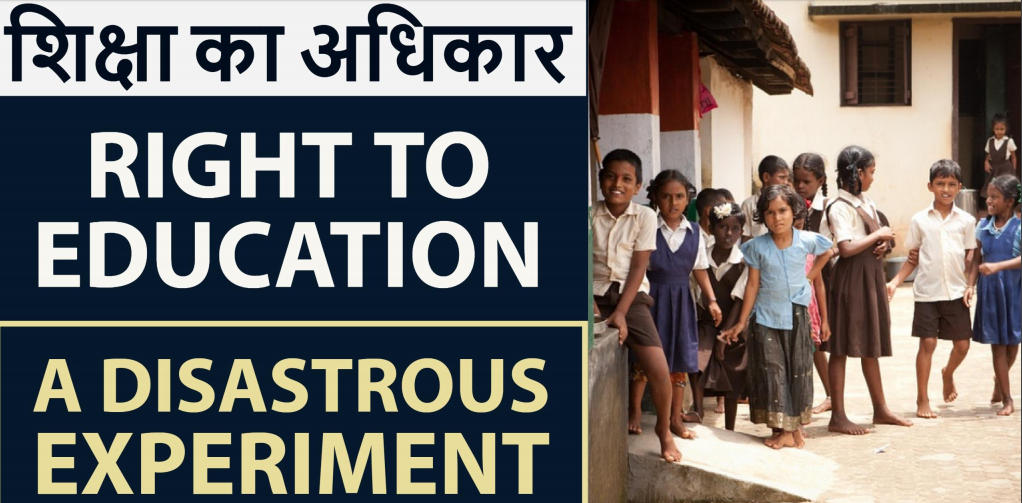Table of Contents
Right to Education (RTE) Act, 2009
• Intention: Education for all
• Section 12 of the RTE obliges all private schools to give at least 25% of their seats to disadvantaged children.
• Reality: Contrary
• It has deprived millions of children of their right to education by closing down schools.
School Killer Sections of RTE
• As per Section 18 of RTE,
• A private unaided school must obtain a licence from government.
• A private unaided school has to fulfil stipulated
Infrastructure norms
Pupil-teacher ratio norms
• Section 19 of RTE,
• It mandates closure of school without
• More tough conditions by various State Governments
Why Government follows such Sections?
• Section 19 convenient for politics.
• Because of 25% seat obligation in private school, trend of migration from Public school to Private school is full on.
• 2015-16: Rajasthan, Maharashtra and Chhattisgarh
• Closed about 24,000 government schools
• Total school enrolment had fallen below 10 students
• Closures expose government incompetence.
• To avoid embarrassment, government enforces Section 19 of RTE and shuts private s
• While these strictures are supposedly quality related, in fact this inputs-focused approach is already discredited internationally in hundreds of studies and meta-analyses.
• And even national data show that raw learning levels of children in these schools are twice (in some states thrice) as high as in government schools.
• By closing down such private schools, government avoids double burden.
• Government schools: maintaining empty school buildings and highly paid teachers (avera
• As per Section 19 of RTE Act: government schools are exempted from penalties for violating the infrastructure norms.
• Outcome of this exemption:
• Only 6.4% of them actually fulfilled the norms by 2016
• Thus the Act shelters infrastructure-deficient government schools from closure, and applies double standards.
• The disastrous act does not stop here…
• Section 6 of RTE
• Obligates state governments to establish neighbourhood public schools in all localities.
• This means creating more such unproductive, highly
inefficient schools which are already the last choice of any parents.
• Official data from U-DISE: 2010 to 2016 x Enrolment in public eleme
• The average school size in these 4.17 lakh schools was a mere 28 students per school.
• monstrously unviable, both pedagogically and economically.
• The total teacher salary bill in these 4.17 lakh ‘small’ government schools was Rs 56,497 crore in 2016-17 (data from NUEPA).
• RTE’s insistence on creating more government schools when such schools have been rapidly emptying has led to grotesque inefficiency, and it constitutes the ruinous triumph of ideology
over sense.
• On top there any state governments have not implemented Section 12 of the Act.
• Uttarakhand and Maharashtra governments : cannot afford
• Karnataka : blaming this clause for privatisation of education
• Some say its anti-Hindu since it applies only to the nonminority (mainly Hindu) schools.
• Problems faced by Private School because of this excuses are real and many.
Low reimbursement rates
Delay in reimbursements
Deficits in reimbursements
Corruption in reimbursements
Political capture
Official interference
Loss of autonomy
• RTE Act’s framers disregarded the evidence on the emptying of government schools.
• Framers were in denial about the pitiably low learning levels, which were driving parents to private schools.
• They merrily focussed on ensuring access to schooling.
• The crying need is for accountability-raising reform that exposes government schools to the rigours of competition from private schools.
• Many countries have benefited by giving public funding (to government and private schools) as vouchers to parents, which empower the latter to hold schools accountable.
• National Education Policy must boldly recommend the scrapping of the harmful Right to Education Act, 2009, and suggest policies based on national and international evidence
on what has worked to improve children’s outcomes.
• The stakes are high for crores of Indian children, and for the country’s growth and prosperity.


























 WhatsApp
WhatsApp